Vertical Farming: Definition, Use, Benefits and Limitations
VerifiedAdded on 2023/06/12
|7
|1997
|59
AI Summary
This study provides a comprehensive overview of vertical farming, including its definition, use, benefits, and limitations. It explains how this innovative technique can help secure sustainable and resilient food systems. The study also discusses the impact of vertical farming on the environment, its ability to withstand unfavorable weather conditions, and the challenges associated with its implementation. The study includes a list of references for further reading.
Contribute Materials
Your contribution can guide someone’s learning journey. Share your
documents today.
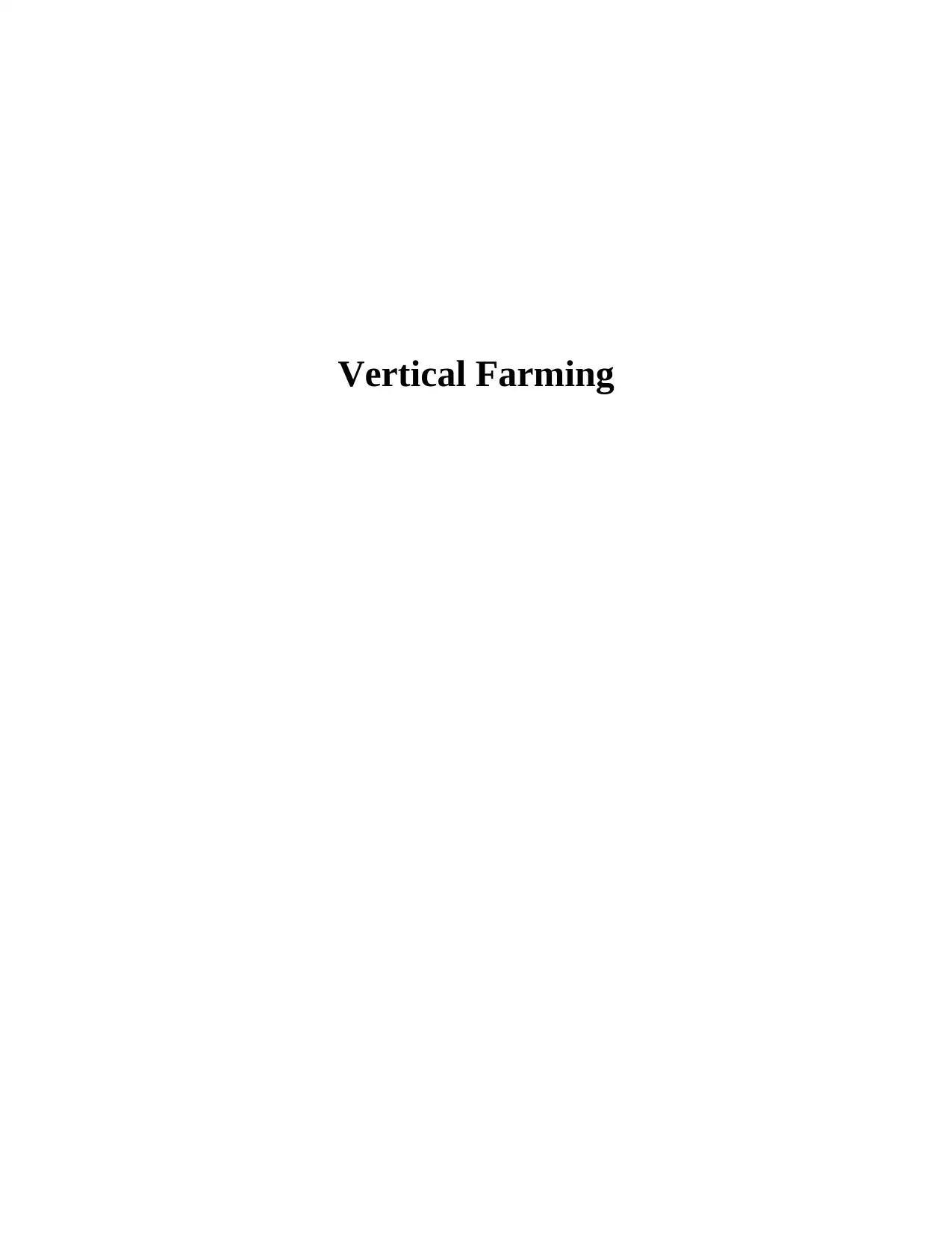
Vertical Farming
Secure Best Marks with AI Grader
Need help grading? Try our AI Grader for instant feedback on your assignments.
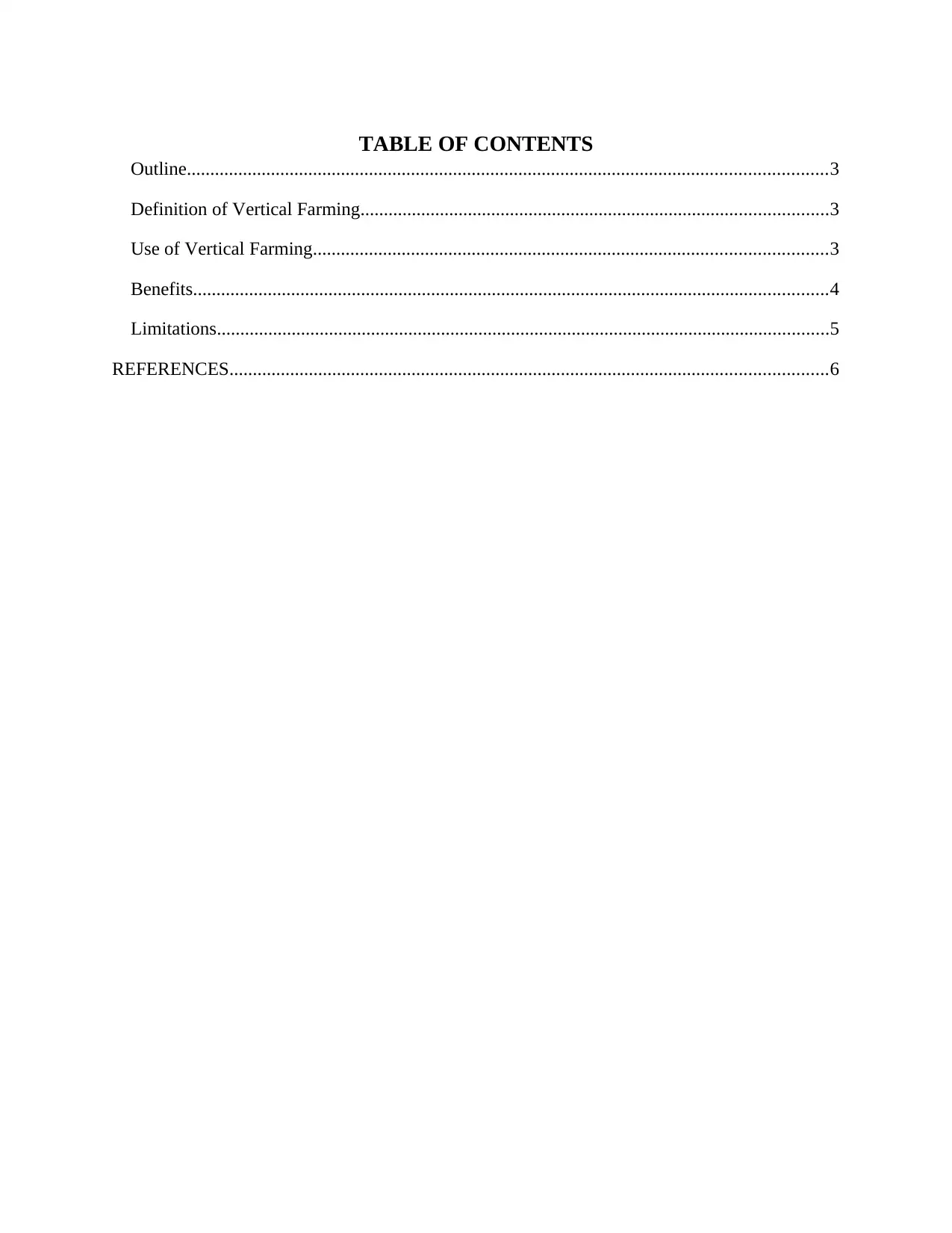
TABLE OF CONTENTS
Outline.........................................................................................................................................3
Definition of Vertical Farming....................................................................................................3
Use of Vertical Farming..............................................................................................................3
Benefits........................................................................................................................................4
Limitations...................................................................................................................................5
REFERENCES................................................................................................................................6
Outline.........................................................................................................................................3
Definition of Vertical Farming....................................................................................................3
Use of Vertical Farming..............................................................................................................3
Benefits........................................................................................................................................4
Limitations...................................................................................................................................5
REFERENCES................................................................................................................................6
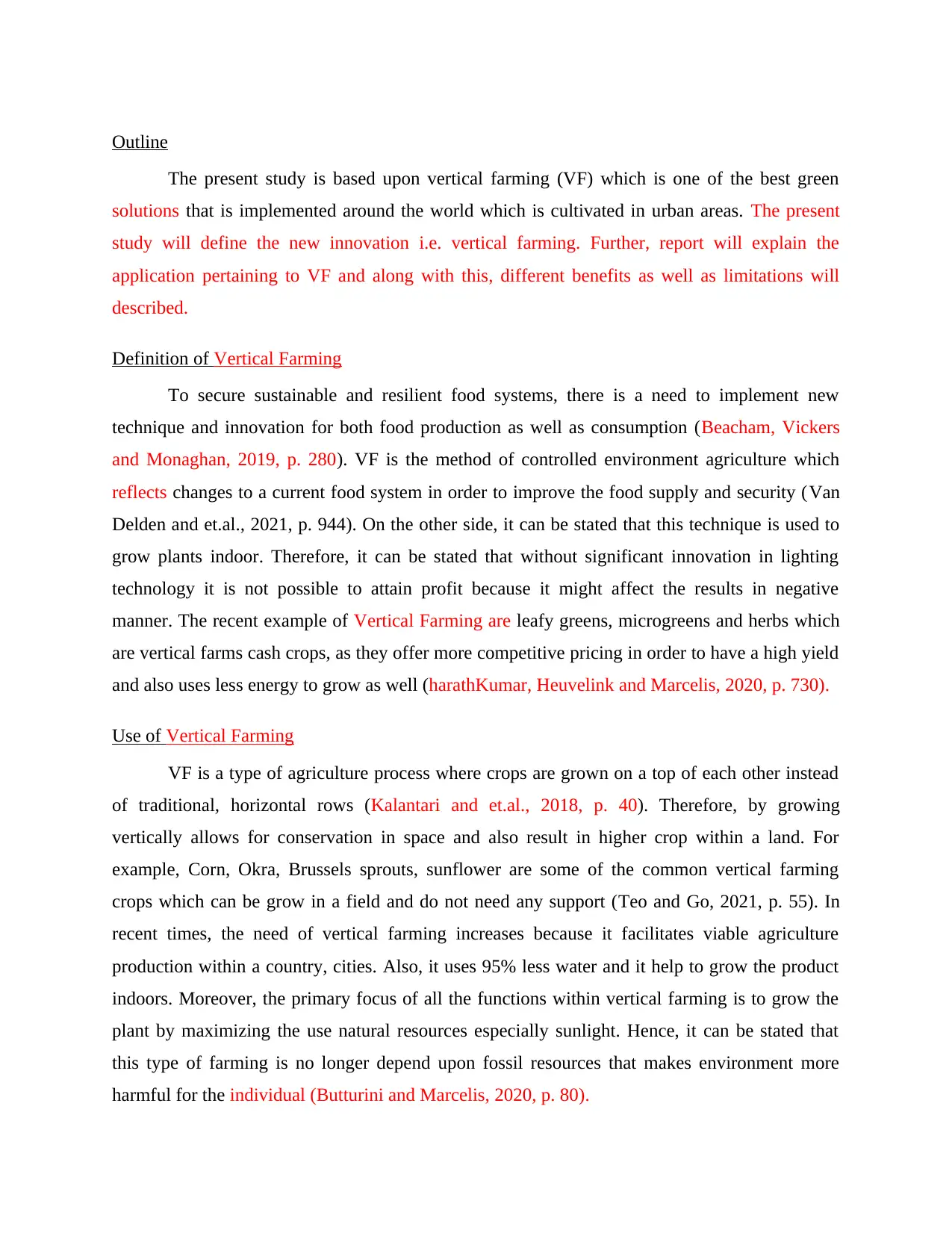
Outline
The present study is based upon vertical farming (VF) which is one of the best green
solutions that is implemented around the world which is cultivated in urban areas. The present
study will define the new innovation i.e. vertical farming. Further, report will explain the
application pertaining to VF and along with this, different benefits as well as limitations will
described.
Definition of Vertical Farming
To secure sustainable and resilient food systems, there is a need to implement new
technique and innovation for both food production as well as consumption (Beacham, Vickers
and Monaghan, 2019, p. 280). VF is the method of controlled environment agriculture which
reflects changes to a current food system in order to improve the food supply and security (Van
Delden and et.al., 2021, p. 944). On the other side, it can be stated that this technique is used to
grow plants indoor. Therefore, it can be stated that without significant innovation in lighting
technology it is not possible to attain profit because it might affect the results in negative
manner. The recent example of Vertical Farming are leafy greens, microgreens and herbs which
are vertical farms cash crops, as they offer more competitive pricing in order to have a high yield
and also uses less energy to grow as well (harathKumar, Heuvelink and Marcelis, 2020, p. 730).
Use of Vertical Farming
VF is a type of agriculture process where crops are grown on a top of each other instead
of traditional, horizontal rows (Kalantari and et.al., 2018, p. 40). Therefore, by growing
vertically allows for conservation in space and also result in higher crop within a land. For
example, Corn, Okra, Brussels sprouts, sunflower are some of the common vertical farming
crops which can be grow in a field and do not need any support (Teo and Go, 2021, p. 55). In
recent times, the need of vertical farming increases because it facilitates viable agriculture
production within a country, cities. Also, it uses 95% less water and it help to grow the product
indoors. Moreover, the primary focus of all the functions within vertical farming is to grow the
plant by maximizing the use natural resources especially sunlight. Hence, it can be stated that
this type of farming is no longer depend upon fossil resources that makes environment more
harmful for the individual (Butturini and Marcelis, 2020, p. 80).
The present study is based upon vertical farming (VF) which is one of the best green
solutions that is implemented around the world which is cultivated in urban areas. The present
study will define the new innovation i.e. vertical farming. Further, report will explain the
application pertaining to VF and along with this, different benefits as well as limitations will
described.
Definition of Vertical Farming
To secure sustainable and resilient food systems, there is a need to implement new
technique and innovation for both food production as well as consumption (Beacham, Vickers
and Monaghan, 2019, p. 280). VF is the method of controlled environment agriculture which
reflects changes to a current food system in order to improve the food supply and security (Van
Delden and et.al., 2021, p. 944). On the other side, it can be stated that this technique is used to
grow plants indoor. Therefore, it can be stated that without significant innovation in lighting
technology it is not possible to attain profit because it might affect the results in negative
manner. The recent example of Vertical Farming are leafy greens, microgreens and herbs which
are vertical farms cash crops, as they offer more competitive pricing in order to have a high yield
and also uses less energy to grow as well (harathKumar, Heuvelink and Marcelis, 2020, p. 730).
Use of Vertical Farming
VF is a type of agriculture process where crops are grown on a top of each other instead
of traditional, horizontal rows (Kalantari and et.al., 2018, p. 40). Therefore, by growing
vertically allows for conservation in space and also result in higher crop within a land. For
example, Corn, Okra, Brussels sprouts, sunflower are some of the common vertical farming
crops which can be grow in a field and do not need any support (Teo and Go, 2021, p. 55). In
recent times, the need of vertical farming increases because it facilitates viable agriculture
production within a country, cities. Also, it uses 95% less water and it help to grow the product
indoors. Moreover, the primary focus of all the functions within vertical farming is to grow the
plant by maximizing the use natural resources especially sunlight. Hence, it can be stated that
this type of farming is no longer depend upon fossil resources that makes environment more
harmful for the individual (Butturini and Marcelis, 2020, p. 80).
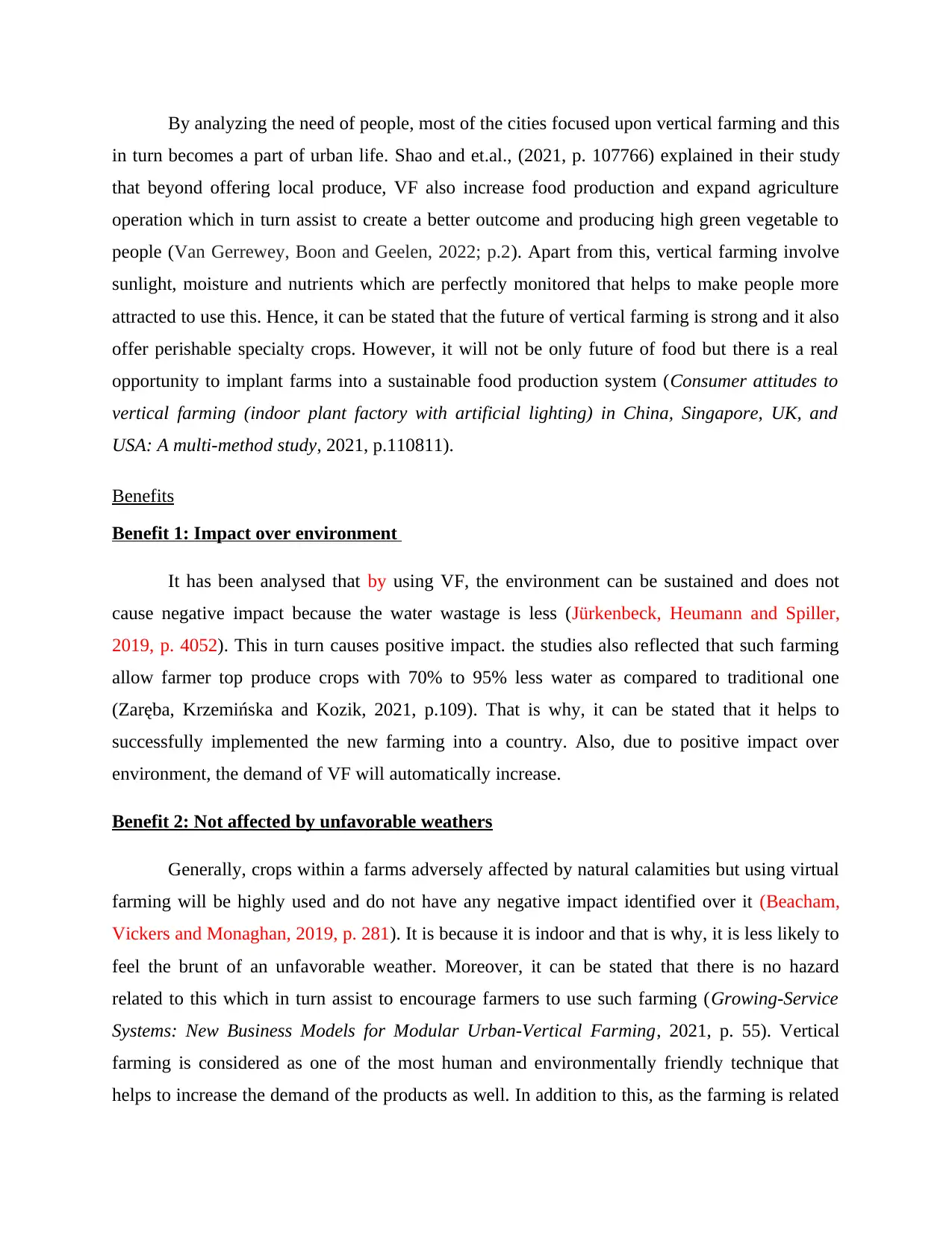
By analyzing the need of people, most of the cities focused upon vertical farming and this
in turn becomes a part of urban life. Shao and et.al., (2021, p. 107766) explained in their study
that beyond offering local produce, VF also increase food production and expand agriculture
operation which in turn assist to create a better outcome and producing high green vegetable to
people (Van Gerrewey, Boon and Geelen, 2022; p.2). Apart from this, vertical farming involve
sunlight, moisture and nutrients which are perfectly monitored that helps to make people more
attracted to use this. Hence, it can be stated that the future of vertical farming is strong and it also
offer perishable specialty crops. However, it will not be only future of food but there is a real
opportunity to implant farms into a sustainable food production system (Consumer attitudes to
vertical farming (indoor plant factory with artificial lighting) in China, Singapore, UK, and
USA: A multi-method study, 2021, p.110811).
Benefits
Benefit 1: Impact over environment
It has been analysed that by using VF, the environment can be sustained and does not
cause negative impact because the water wastage is less (Jürkenbeck, Heumann and Spiller,
2019, p. 4052). This in turn causes positive impact. the studies also reflected that such farming
allow farmer top produce crops with 70% to 95% less water as compared to traditional one
(Zaręba, Krzemińska and Kozik, 2021, p.109). That is why, it can be stated that it helps to
successfully implemented the new farming into a country. Also, due to positive impact over
environment, the demand of VF will automatically increase.
Benefit 2: Not affected by unfavorable weathers
Generally, crops within a farms adversely affected by natural calamities but using virtual
farming will be highly used and do not have any negative impact identified over it (Beacham,
Vickers and Monaghan, 2019, p. 281). It is because it is indoor and that is why, it is less likely to
feel the brunt of an unfavorable weather. Moreover, it can be stated that there is no hazard
related to this which in turn assist to encourage farmers to use such farming (Growing-Service
Systems: New Business Models for Modular Urban-Vertical Farming, 2021, p. 55). Vertical
farming is considered as one of the most human and environmentally friendly technique that
helps to increase the demand of the products as well. In addition to this, as the farming is related
in turn becomes a part of urban life. Shao and et.al., (2021, p. 107766) explained in their study
that beyond offering local produce, VF also increase food production and expand agriculture
operation which in turn assist to create a better outcome and producing high green vegetable to
people (Van Gerrewey, Boon and Geelen, 2022; p.2). Apart from this, vertical farming involve
sunlight, moisture and nutrients which are perfectly monitored that helps to make people more
attracted to use this. Hence, it can be stated that the future of vertical farming is strong and it also
offer perishable specialty crops. However, it will not be only future of food but there is a real
opportunity to implant farms into a sustainable food production system (Consumer attitudes to
vertical farming (indoor plant factory with artificial lighting) in China, Singapore, UK, and
USA: A multi-method study, 2021, p.110811).
Benefits
Benefit 1: Impact over environment
It has been analysed that by using VF, the environment can be sustained and does not
cause negative impact because the water wastage is less (Jürkenbeck, Heumann and Spiller,
2019, p. 4052). This in turn causes positive impact. the studies also reflected that such farming
allow farmer top produce crops with 70% to 95% less water as compared to traditional one
(Zaręba, Krzemińska and Kozik, 2021, p.109). That is why, it can be stated that it helps to
successfully implemented the new farming into a country. Also, due to positive impact over
environment, the demand of VF will automatically increase.
Benefit 2: Not affected by unfavorable weathers
Generally, crops within a farms adversely affected by natural calamities but using virtual
farming will be highly used and do not have any negative impact identified over it (Beacham,
Vickers and Monaghan, 2019, p. 281). It is because it is indoor and that is why, it is less likely to
feel the brunt of an unfavorable weather. Moreover, it can be stated that there is no hazard
related to this which in turn assist to encourage farmers to use such farming (Growing-Service
Systems: New Business Models for Modular Urban-Vertical Farming, 2021, p. 55). Vertical
farming is considered as one of the most human and environmentally friendly technique that
helps to increase the demand of the products as well. In addition to this, as the farming is related
Secure Best Marks with AI Grader
Need help grading? Try our AI Grader for instant feedback on your assignments.
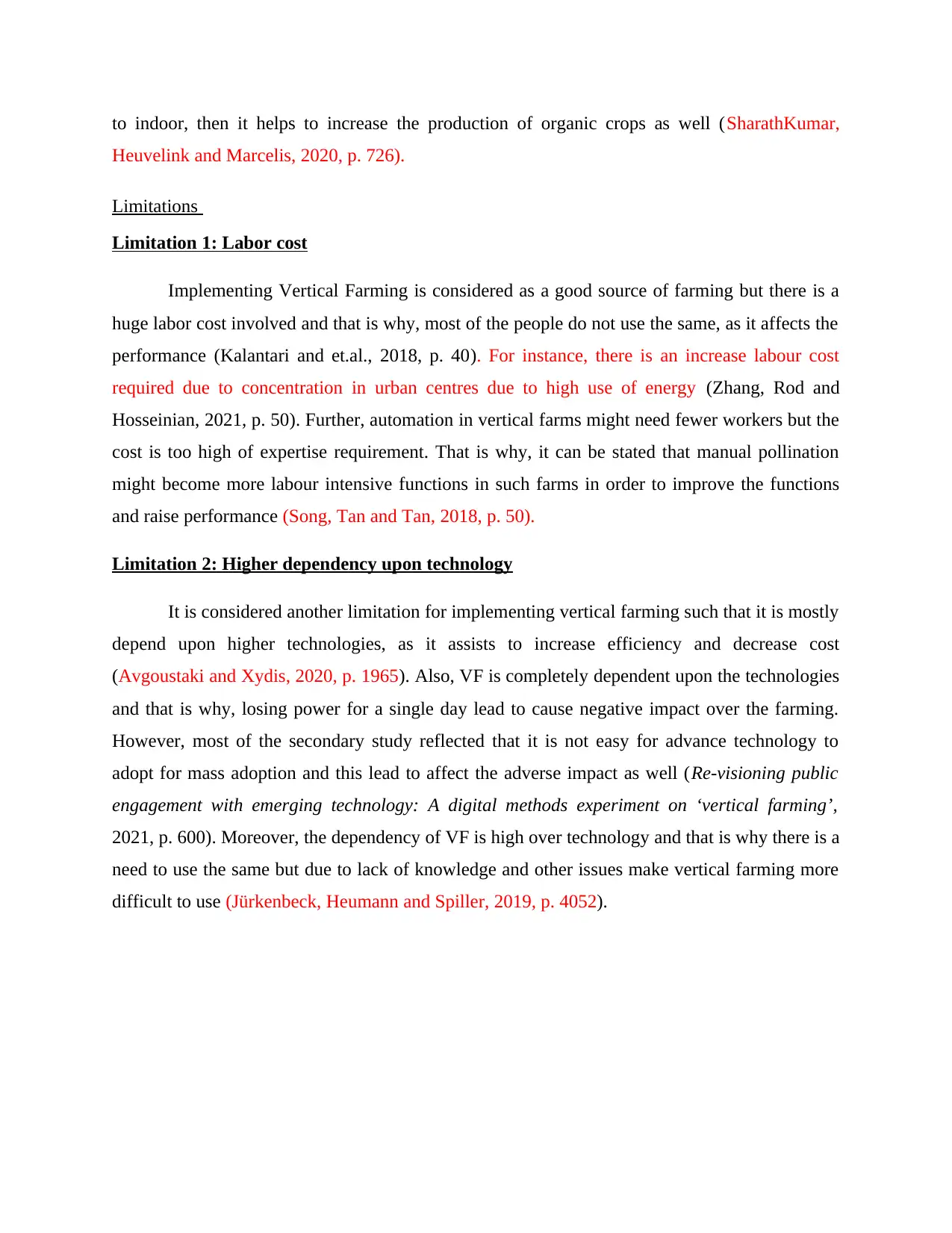
to indoor, then it helps to increase the production of organic crops as well (SharathKumar,
Heuvelink and Marcelis, 2020, p. 726).
Limitations
Limitation 1: Labor cost
Implementing Vertical Farming is considered as a good source of farming but there is a
huge labor cost involved and that is why, most of the people do not use the same, as it affects the
performance (Kalantari and et.al., 2018, p. 40). For instance, there is an increase labour cost
required due to concentration in urban centres due to high use of energy (Zhang, Rod and
Hosseinian, 2021, p. 50). Further, automation in vertical farms might need fewer workers but the
cost is too high of expertise requirement. That is why, it can be stated that manual pollination
might become more labour intensive functions in such farms in order to improve the functions
and raise performance (Song, Tan and Tan, 2018, p. 50).
Limitation 2: Higher dependency upon technology
It is considered another limitation for implementing vertical farming such that it is mostly
depend upon higher technologies, as it assists to increase efficiency and decrease cost
(Avgoustaki and Xydis, 2020, p. 1965). Also, VF is completely dependent upon the technologies
and that is why, losing power for a single day lead to cause negative impact over the farming.
However, most of the secondary study reflected that it is not easy for advance technology to
adopt for mass adoption and this lead to affect the adverse impact as well (Re-visioning public
engagement with emerging technology: A digital methods experiment on ‘vertical farming’,
2021, p. 600). Moreover, the dependency of VF is high over technology and that is why there is a
need to use the same but due to lack of knowledge and other issues make vertical farming more
difficult to use (Jürkenbeck, Heumann and Spiller, 2019, p. 4052).
Heuvelink and Marcelis, 2020, p. 726).
Limitations
Limitation 1: Labor cost
Implementing Vertical Farming is considered as a good source of farming but there is a
huge labor cost involved and that is why, most of the people do not use the same, as it affects the
performance (Kalantari and et.al., 2018, p. 40). For instance, there is an increase labour cost
required due to concentration in urban centres due to high use of energy (Zhang, Rod and
Hosseinian, 2021, p. 50). Further, automation in vertical farms might need fewer workers but the
cost is too high of expertise requirement. That is why, it can be stated that manual pollination
might become more labour intensive functions in such farms in order to improve the functions
and raise performance (Song, Tan and Tan, 2018, p. 50).
Limitation 2: Higher dependency upon technology
It is considered another limitation for implementing vertical farming such that it is mostly
depend upon higher technologies, as it assists to increase efficiency and decrease cost
(Avgoustaki and Xydis, 2020, p. 1965). Also, VF is completely dependent upon the technologies
and that is why, losing power for a single day lead to cause negative impact over the farming.
However, most of the secondary study reflected that it is not easy for advance technology to
adopt for mass adoption and this lead to affect the adverse impact as well (Re-visioning public
engagement with emerging technology: A digital methods experiment on ‘vertical farming’,
2021, p. 600). Moreover, the dependency of VF is high over technology and that is why there is a
need to use the same but due to lack of knowledge and other issues make vertical farming more
difficult to use (Jürkenbeck, Heumann and Spiller, 2019, p. 4052).

REFERENCES
Books and Journals
Avgoustaki, D.D. and Xydis, G., 2020. Indoor vertical farming in the urban nexus context:
Business growth and resource savings. Sustainability. 12(5). p.1965.
Beacham, A. M., Vickers, L. H. and Monaghan, J. M., 2019. Vertical farming: a summary of
approaches to growing skywards. The Journal of Horticultural Science and
Biotechnology. 94(3). pp.277-283.
Butturini, M. and Marcelis, L.F., 2020. Vertical farming in Europe: Present status and outlook.
In Plant Factory (pp. 77-91). Academic Press.
Jürkenbeck, K., Heumann, A. and Spiller, A., 2019. Sustainability matters: Consumer acceptance
of different vertical farming systems. Sustainability. 11(15). p.4052.
Kalantari, F. and et.al., 2018. Opportunities and challenges in sustainability of vertical farming:
A review. Journal of Landscape Ecology. 11(1). pp.35-60.
Shao, Y. and et.al., 2021. The effects of vertical farming on indoor carbon dioxide concentration
and fresh air energy consumption in office buildings. Building and Environment. 195.
p.107766.
SharathKumar, M., Heuvelink, E. and Marcelis, L.F., 2020. Vertical farming: moving from
genetic to environmental modification. Trends in plant science. 25(8). pp.724-727.
Song, X.P., Tan, H.T. and Tan, P.Y., 2018. Assessment of light adequacy for vertical farming in
a tropical city. Urban forestry & urban greening. 29. pp.49-57.
Teo, Y. L. and Go, Y. I., 2021. Techno-economic-environmental analysis of solar/hybrid/storage
for vertical farming system: A case study, malaysia. Renewable Energy Focus. 37. pp.50-
67.
Van Delden, S. H. and et.al., 2021. Current status and future challenges in implementing and
upscaling vertical farming systems. Nature Food. 2(12). pp.944-956.
Van Gerrewey, T., Boon, N. and Geelen, D., 2022. Vertical Farming: The Only Way Is
Up?. Agronomy. 12(1). p.2.
Zaręba, A., Krzemińska, A. and Kozik, R., 2021. Urban Vertical Farming as an Example of
Nature-Based Solutions Supporting a Healthy Society Living in the Urban
Environment. Resources. 10(11). p.109.
Zhang, Z., Rod, M. and Hosseinian, F., 2021. A Comprehensive Review on Sustainable
Industrial Vertical Farming Using Film Farming Technology. Sustainable Agriculture
Research. 10(526-2021-496). pp.46-53.
Online
Books and Journals
Avgoustaki, D.D. and Xydis, G., 2020. Indoor vertical farming in the urban nexus context:
Business growth and resource savings. Sustainability. 12(5). p.1965.
Beacham, A. M., Vickers, L. H. and Monaghan, J. M., 2019. Vertical farming: a summary of
approaches to growing skywards. The Journal of Horticultural Science and
Biotechnology. 94(3). pp.277-283.
Butturini, M. and Marcelis, L.F., 2020. Vertical farming in Europe: Present status and outlook.
In Plant Factory (pp. 77-91). Academic Press.
Jürkenbeck, K., Heumann, A. and Spiller, A., 2019. Sustainability matters: Consumer acceptance
of different vertical farming systems. Sustainability. 11(15). p.4052.
Kalantari, F. and et.al., 2018. Opportunities and challenges in sustainability of vertical farming:
A review. Journal of Landscape Ecology. 11(1). pp.35-60.
Shao, Y. and et.al., 2021. The effects of vertical farming on indoor carbon dioxide concentration
and fresh air energy consumption in office buildings. Building and Environment. 195.
p.107766.
SharathKumar, M., Heuvelink, E. and Marcelis, L.F., 2020. Vertical farming: moving from
genetic to environmental modification. Trends in plant science. 25(8). pp.724-727.
Song, X.P., Tan, H.T. and Tan, P.Y., 2018. Assessment of light adequacy for vertical farming in
a tropical city. Urban forestry & urban greening. 29. pp.49-57.
Teo, Y. L. and Go, Y. I., 2021. Techno-economic-environmental analysis of solar/hybrid/storage
for vertical farming system: A case study, malaysia. Renewable Energy Focus. 37. pp.50-
67.
Van Delden, S. H. and et.al., 2021. Current status and future challenges in implementing and
upscaling vertical farming systems. Nature Food. 2(12). pp.944-956.
Van Gerrewey, T., Boon, N. and Geelen, D., 2022. Vertical Farming: The Only Way Is
Up?. Agronomy. 12(1). p.2.
Zaręba, A., Krzemińska, A. and Kozik, R., 2021. Urban Vertical Farming as an Example of
Nature-Based Solutions Supporting a Healthy Society Living in the Urban
Environment. Resources. 10(11). p.109.
Zhang, Z., Rod, M. and Hosseinian, F., 2021. A Comprehensive Review on Sustainable
Industrial Vertical Farming Using Film Farming Technology. Sustainable Agriculture
Research. 10(526-2021-496). pp.46-53.
Online
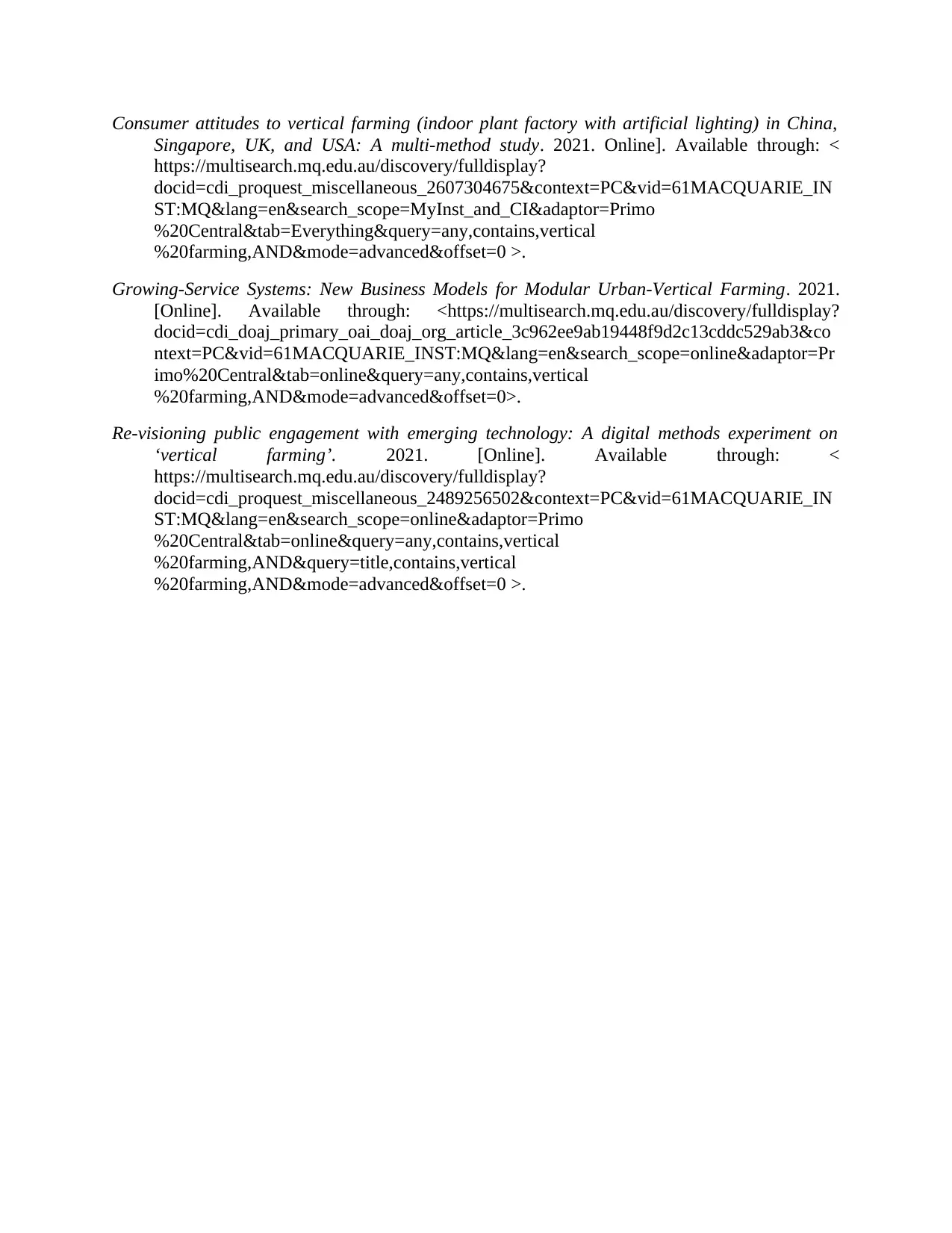
Consumer attitudes to vertical farming (indoor plant factory with artificial lighting) in China,
Singapore, UK, and USA: A multi-method study. 2021. Online]. Available through: <
https://multisearch.mq.edu.au/discovery/fulldisplay?
docid=cdi_proquest_miscellaneous_2607304675&context=PC&vid=61MACQUARIE_IN
ST:MQ&lang=en&search_scope=MyInst_and_CI&adaptor=Primo
%20Central&tab=Everything&query=any,contains,vertical
%20farming,AND&mode=advanced&offset=0 >.
Growing-Service Systems: New Business Models for Modular Urban-Vertical Farming. 2021.
[Online]. Available through: <https://multisearch.mq.edu.au/discovery/fulldisplay?
docid=cdi_doaj_primary_oai_doaj_org_article_3c962ee9ab19448f9d2c13cddc529ab3&co
ntext=PC&vid=61MACQUARIE_INST:MQ&lang=en&search_scope=online&adaptor=Pr
imo%20Central&tab=online&query=any,contains,vertical
%20farming,AND&mode=advanced&offset=0>.
Re-visioning public engagement with emerging technology: A digital methods experiment on
‘vertical farming’. 2021. [Online]. Available through: <
https://multisearch.mq.edu.au/discovery/fulldisplay?
docid=cdi_proquest_miscellaneous_2489256502&context=PC&vid=61MACQUARIE_IN
ST:MQ&lang=en&search_scope=online&adaptor=Primo
%20Central&tab=online&query=any,contains,vertical
%20farming,AND&query=title,contains,vertical
%20farming,AND&mode=advanced&offset=0 >.
Singapore, UK, and USA: A multi-method study. 2021. Online]. Available through: <
https://multisearch.mq.edu.au/discovery/fulldisplay?
docid=cdi_proquest_miscellaneous_2607304675&context=PC&vid=61MACQUARIE_IN
ST:MQ&lang=en&search_scope=MyInst_and_CI&adaptor=Primo
%20Central&tab=Everything&query=any,contains,vertical
%20farming,AND&mode=advanced&offset=0 >.
Growing-Service Systems: New Business Models for Modular Urban-Vertical Farming. 2021.
[Online]. Available through: <https://multisearch.mq.edu.au/discovery/fulldisplay?
docid=cdi_doaj_primary_oai_doaj_org_article_3c962ee9ab19448f9d2c13cddc529ab3&co
ntext=PC&vid=61MACQUARIE_INST:MQ&lang=en&search_scope=online&adaptor=Pr
imo%20Central&tab=online&query=any,contains,vertical
%20farming,AND&mode=advanced&offset=0>.
Re-visioning public engagement with emerging technology: A digital methods experiment on
‘vertical farming’. 2021. [Online]. Available through: <
https://multisearch.mq.edu.au/discovery/fulldisplay?
docid=cdi_proquest_miscellaneous_2489256502&context=PC&vid=61MACQUARIE_IN
ST:MQ&lang=en&search_scope=online&adaptor=Primo
%20Central&tab=online&query=any,contains,vertical
%20farming,AND&query=title,contains,vertical
%20farming,AND&mode=advanced&offset=0 >.
1 out of 7
Related Documents
Your All-in-One AI-Powered Toolkit for Academic Success.
+13062052269
info@desklib.com
Available 24*7 on WhatsApp / Email
![[object Object]](/_next/static/media/star-bottom.7253800d.svg)
Unlock your academic potential
© 2024 | Zucol Services PVT LTD | All rights reserved.
